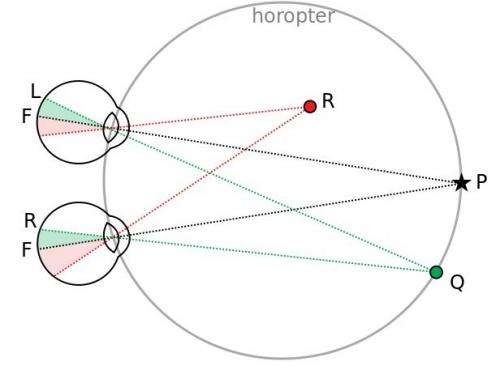October 15, 2013 weblog
Psychologist claims study shows people can see in 3D with just one eye

(Medical Xpress)—Psychologist Dhanraj Vishwanath, working with Paul Hibbard, both at the University of St. Andrews in Scotland, has published a paper in the journal Psychological Science, claiming to be able to prove that people can see in 3D using just one eye. He says it can be done by viewing a picture through a piece of paper with a small hole cut in it.
The modern world has adopted the idea that in order for people to see three dimensional images—in real life and at the movies—two eyes are required. They brain reads the dual 2D imagery and converts it to 3D, or so it's believed. But now, Vishwanath says that conventional thinking isn't quite right. He notes that scientists and others have known for some time that viewing photographs through a small aperture provides some degree of 3D perception, but it's been ignored because the two-eyed version provides a much richer experience. He adds that in some circles it's not been taken seriously. In his paper he claims that he's found a way to prove that only one eye is needed for true 3D.
An inability to see in 3D is not limited to people with vision in just one eye, it also impacts those with misaligned sight—the two eyeballs focus on two different places—in order to compensate, imagery from the less dominant eye is generally ignored, except for the periphery. Prior research has suggested that up to 15 percent of people have some degree of strabismus (aka lazy eye), the medical term for the condition. Vishwanath claims that using simple technology could allow such people to not only experience 3D movies the same way as other people, but to experience 3D first hand in real life. He believes the experience would likely induce many with the condition to seek treatment to fix their vision problem. As for entertainment, Vishwanath suggests that once a certain degree of resolution is reached with flat screen TV's those who wish to do so, could see the special 3D effects Hollywood has added, simply by punching a small hole in a piece of cardboard and peering through it at the TV—with just one eye.
More information: Seeing in 3-D With Just One Eye: Stereopsis Without Binocular Vision, Dhanraj Vishwanath, Paul B. Hibbard, Published online before print July 26, 2013, DOI: 10.1177/0956797613477867
Abstract
Humans can perceive depth when viewing with one eye, and even when viewing a two-dimensional picture of a three-dimensional scene. However, viewing a real scene with both eyes produces a more compelling three-dimensional experience of immersive space and tangible solid objects. A widely held belief is that this qualitative visual phenomenon (stereopsis) is a by-product of binocular vision. In the research reported here, we empirically established, for the first time, the qualitative characteristics associated with stereopsis to show that they can occur for static two-dimensional pictures without binocular vision. Critically, we show that stereopsis is a measurable qualitative attribute and that its induction while viewing pictures is not consistent with standard explanations based on depth-cue conflict or the perception of greater depth magnitude. These results challenge the conventional understanding of the underlying cause, variation, and functional role of stereopsis.
© 2013 Medical Xpress


















